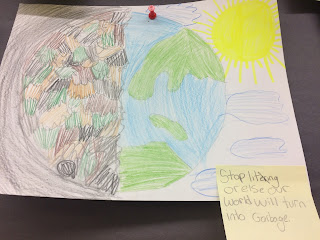We have been looking at the concept of 'main idea' (aka THEME) primarily within the context of our narrative study. It is, for example, one of the questions on the reading comprehension assessment, the CASI.
But we have broadened our study of 'main idea' to include different narrative forms: yes, it is in written narratives. It is also in media narratives (like short films) and musicals (like the Little Mermaid production we went to see).
It is also in Art.
So far in visual arts, we have examined (most) of the elements of design: line, shape/form, texture, value/colour, and (soon) shape.
We have looked at how different aspects of these elements convey different feelings, moods and ideas.
We have also started to look at how those elements communicate in a 'silent language'. They are used by artists to communicate a 'main idea'/theme.
We have just started this examination! We are examining artistic works to see how those elements are used to convey an overall message. This will eventually result in an art analysis paragraph.
We are also, as artists ourselves, exploring how we can use elements to convey an overall message.
In our geography curriculum, both Gr. 7 and 8 look at the preservation of natural resources and the issue of sustainability.
To practice creating a 'main idea' via artistic elements, I asked students to write their main idea on a stickee...and then try to match that main idea visually, in a drawing. Here are some of what the students created. (Take particular note of their choice/use of the art elements (especially line, shape/form, colour) to communicate their idea!)
In another instance, I invited The Simcoe County Greenbelt Coalition in to give a talk about water and how human activities/choices impact this natural resource.
I then asked students to convey the main idea, or gist, of the presentation in a composed photograph, using found objects in the classroom/school. This was indeed a bit of a challenge!
Again, the results were very interesting! Make sure you read what they posted, as that is the message they were trying to convey visually.
You can see how creating art in this context pushes students to the highest levels of Bloom's Taxonomy.
We will continue to explore this interesting intersection of creativity, visual communication, and theme/message/main idea, across additional curriculum... all of which aids us in our ability to not just creators of messages but also critical and aware 'decoders' of messages.



















































